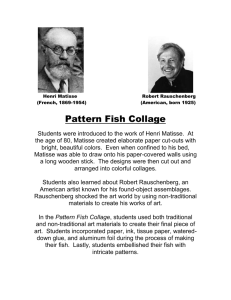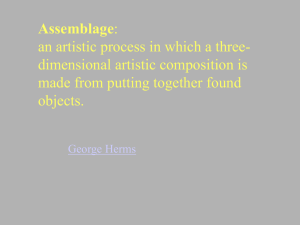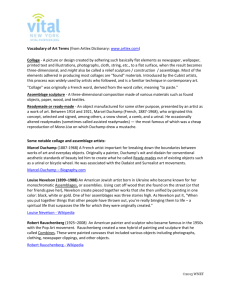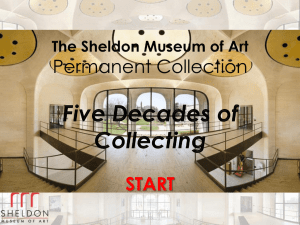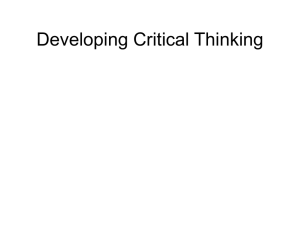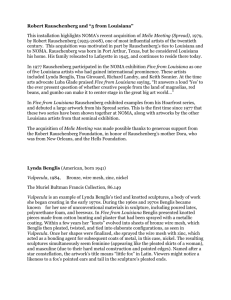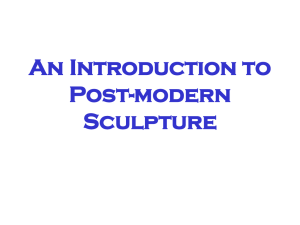robert rauschenberg's environmental activism
advertisement
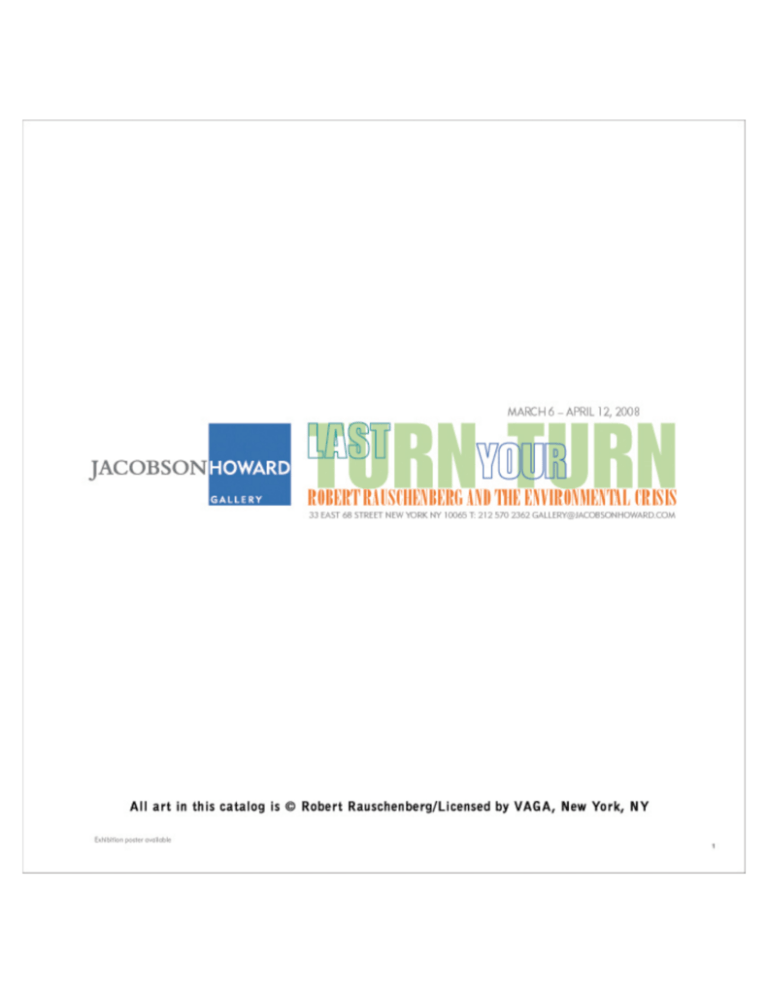
ROBERT RAUSCHENBERG’S ENVIRONMENTAL ACTIVISM On December 8, 1991, the Secretary General of the United Nations, Maurice F. Strong held an inaugural ceremony for the Earth Summit Committee to launch an Earth Pledge in connection with the upcoming United Nations Conference on Environment and Development. At that ceremony, attended by 600 people, Robert Rauschenberg unveiled a new painting, Last Turn-Your Turn, which included the pledge and became the official picture of the United Nations conference. The title of the painting summarizes Rauschenberg’s message about the urgent need for each of us to address the environmental crisis that the world faces today. Known as the Earth Summit and held in Rio de Janeiro, the United Nations Conference on Environment and Development was convened June 3 to June 14, 1992 and attracted a remarkable 178 governments, including all industrialized nations.118 governments sent their heads of state. Some 2,400 non-governmental agencies (NGOs) also participated with a total of 17,000 people meeting at the Earth Summit. Rauschenberg attended the conference at the suggestion of his long time friend and attorney Theodore Kheel. Kheel was head of the Earth Summit Committee and formed a nonprofit at that time to promote the Earth Pledge and its purLast Turn – Your Turn (Earth Summit ’92 The United Nations Conference on Environment and Development Print), 1991, Offset lithograph, 25 x 26 inches, From an edition of 200 published by the Robert Rauschenberg Foundation, printed by Ivy Hill through the auspices of Universal Limited Art Editions, Inc. Art © Robert Rauschenberg and U.L.A.E./Licensed by VAGA, New York, NY Published by U.L.A.E. poses. That nonprofit which is supporting this exhibition is known today as the Nurture Nature Foundation, and its mission remains the original one of furthering awareness of the pledge. A related nonprofit, the Earth Pledge Foundation, has also been established to achieve this end, and Nobel Peace Prize winner Al Gore recently has begun to promote the adoption of a Live Earth Pledge with a similar purpose. The need to address the issues Rauschenberg so dramatically highlighted in Last Turn-Your Turn is even more urgent in 2008 than it was in 1991. 1 For Rauschenberg, Kheel, and much of the world, the 1992 in order to help support the summit. The title of the work Earth Summit was a revelation. It focused on a number cuts to the essence of Rauschenberg’s idea. In his view, of treaties, perhaps the most important of which was the the situation is critical—perhaps the last chance—and it is United Nations Framework Convention on Climate Change. the responsibility of each of us to contribute to the solution. As a result of that treaty, the conclusion was reached that The painting and resulting prints are visually dynamic. Cool global warming, caused by greenhouse gases, provided the green and blue tones contrast with hot reds and yellows. The greatest single threat to world ecology. Further, the sum- dominant imagery amid the cooler colors is lush tropical veg- mit established a yearly Conference of the Parties to the etation, while that in red consists of barren trees. Featured Convention on Climate Change with the intent of monitoring in the lower section, a young child painted in burning red is the agreement to lower greenhouse gases to the 1990 level. only partly protected from the sun by an umbrella. In the right During the 1997 conference in Kyoto, it was learned that, quadrant, Atlas shouldering the burden of the world provides since the Earth Summit, greenhouse gases had not declined a visual parallel to the angle of the umbrella over the child. but instead actually increased. This discovery led in turn, to This pair of images indicates both the hope and difficulty of the 1997 Kyoto Protocol to reduce greenhouse gases. That the task ahead. At the top of the work, Rauschenberg has protocol has been signed by 174 nations but not ratified by hand-written the pledge signed by thousands at the sum- The United States, the largest single emitter of carbon diox- mit. “… I pledge to make the earth a secure and hospitable ide from the burning of fossil fuels. place for present and future generations.” If the meaning of On the issue of political involvement, see Roni Feinstein, “Rauschenberg: Solutions for a Small Planet,” Art in America (February 1998), 66-79 and Robert S. Mattison, Robert Rauschenberg: Breaking Boundaries (London and New Haven: Yale University Press, 2003). Rauschenberg’s piece sounds straightforward, it is. The artThe focus of the Earth Summit was governmental legislation ist is using a forceful visual vocabulary developed over de- to reduce global warming. Rauschenberg’s most important cades of his long career for mass communication, a social insight, made verbally at the conference and in art works statement that will reach the widest range of people. to prepare for it, was the idea of individual responsibility. In the face of legislative initiatives made by governments, For Theodore Kheel, the Earth Summit provided a defining Rauschenberg asked, “What can the individual do?” His be- moment. As one of the nation’s leading labor arbitrators, lief is that without individual commitment legislation cannot Kheel had long been an advocate for workers rights and be effective. In his view, “Once the individual has changed, safety as well as such issues as public transportation. At the the world can change.” Rauschenberg’s attitude fits with his summit, Kheel recognized global warming as the threat of long-held populist beliefs, revealed in his art and related ac- our age. He also understood that environment and devel- tivities, and it is prescient of today’s emphasis on the role opment are both laudable goals. In order for a successful that each of us plays in the ecological system.1 solution to the ecological problem, they could not compete with each other but must be viewed as cooperative. From Rauschenberg’s painting Last Turn-Your Turn subsequent- this notion comes the idea of sustainability. The situation ly was produced as a print edition of 200 signed by the artist provided a perfect challenge for one of the finest arbitrators Eco-Echo III 1993, Acrylic and silkscreened acrylic on aluminum and Lexan, with sonaractivated motor, 88 x 73 x 26 inches Made in collaboration with Saff Tech Arts Notably, a photograph of Rauschenberg and his family boating on the Bayou appears at the center of his monumental print Autobiography (1968). 3 Walter Hopps, Robert Rauschenberg: The Early 1950s (Houston: Houston Fine arts Press, 1991), 162. 4 Timothy W. Luke, “Art and the Environmental Crisis: From Commodity Aesthetic to Ecology Aesthetic,” Art Journal (Summer 1992), 72-76. See also Robert S. Mattison, Made By Nature (exhibition catalogue), Dorsky Gallery Curatorial Programs, Long Island City, New York (September 8October 27, 2002). 5 Mary Lynn Kotz, Robert Rauschenberg: Art and Life (New York: Harry N. Abrams, 1990), 178. 2 in American history. Since the Earth Summit, Kheel has de- Fuller on the construction of a geodesic dome. An early en- voted his attention to establishing and supporting numerous vironmental activist, Fuller was a prophet of sustainable de- foundations like Earth Pledge and Nurture Nature that in- velopment and inventor of technologies that would work in vestigate and provide solutions to environmental issues. For harmony with the natural world. Parallels between Fuller’s Rauschenberg, the summit focused his thinking about the and Rauschenberg’s stances are significant. environment and technology, two of his lifelong fascinations. It acted like a lens for environmental issues that had been Settled in New York, Rauschenberg created a radical se- present in his career for decades. The background to this ries of dirt paintings, of which the single surviving example spotlight is worth tracing. is Dirt Painting (for John Cage) of c. 1953. On one level, these paintings question the notion of art as commodity. On Rauschenberg’s childhood in Port Arthur, Texas, once the the other, their irregular beauty highlights Rauschenberg’s center of the largest oil refining network in America, condi- involvement with the processes and materials of the natu- tioned him to concerns about nature and industrial develop- ral world. The largest dirt painting was Growing Painting, ment. In this oil town, both the economic necessity of indus- documented in a photograph by Rauschenberg when it was try and its disfigurement of the environment must have been shown in the third Stable Gallery annual exhibition in January abundantly clear. Rauschenberg’s father, whose job de- 1954. 3 In a six-foot vertical box frame, Rauschenberg com- pended on the oil industry, also took the family on frequent bined earth, seeds, tufts of grass, and other organic materi- nature outings into the Bayou, and young Rauschenberg als. The work is a remarkable predecessor not only to the kept dogs, chickens and a goat as treasured pets. Later, Earth Art movement but also to the use of biological materi- images of such animals as well as industrial structures ap- als that actually grow and decay in recent works by younger pear in his work. artists. 4 At the Stable exhibition, Rauschenberg showed up 2 regularly to water his piece. While this activity was taken as Rauschenberg’s burgeoning artistic interests led him to study an iconoclastic gesture, the artist actually intended it as a at Black Mountain College in North Carolina, where in 1951 sign of responsibility, a notion related to Rauschenberg’s he met John Cage and Merce Cunningham and began a life- commentary on the Earth Summit. Rauschenberg noted, long friendship. Cage, thirteen years Rauschenberg’s senior, “Those paintings were about looking and caring. Those had already developed a deep involvement with the natural pieces would literally die if you didn’t water them.”5 environment both in terms of personal lifestyle and adoption of organic processes for musical composition. Cage’s own During his early years in New York, Rauschenberg created interest had resulted from his study of Eastern philosophies his important Combine paintings which reveal his fascina- and extensive reading of Henry David Thoreau, whose jour- tion with the manmade urban world as an expression of the nals became one of his bibles. At Black Mountain during the complexity and excitement of modern life. At the same time, summer of 1949, Rauschenberg worked with Buckminster references to nature appear with great frequency. For in- Sterling / Whirl 1993, Acrylic screen print, acrylic hand painting, fire wax and silver pigment dust on paper with acrylic screen print on Lexan in aluminum frame, 63 3/4 x 44 inches From an edition of 17 produced by Saff Tech Arts Another interpretation relating to the Ganymede myth is proposed in Kenneth Bendiner, “Robert Rauschenberg’s Canyon,” Arts Magazine (June 1982), 57-59. The openness of Rauschenberg’s work to such varied decoding is one of its primary characteristics. 7 Kotz, 138. 6 stance, Untitled (1955, The Museum of Contemporary art, E.A.T. (Experiments in Art and Technology). E.A.T. sought to Los Angeles, Panza Collection), widely considered one of promote the use of technology for non-industrial purposes the artist’s most autobiographical works, contains a stuffed by arranging collaborations between artists and engineers. Dominique hen as well as numerous nature photographs and Rauschenberg’s involvement with E.A.T. encouraged his ten- reproductions of Old Master landscape paintings. Canyon dency to connect his art to public positions and to engage in (1959, The Sonnabend Collection) features a taxidermic collaborative projects. As one E.A.T. project, Rauschenberg eagle that once belonged to one of Teddy Roosevelt’s created Mud Muse (1968-71, Moderna Museet, Stockholm) “Rough Riders” set against a flattened portion of an oil in collaboration with engineers from the company Teledyne. drum and near a bucolic photograph of Rauschenberg’s son The piece consists of a 9x12 foot tank filled with driller’s mud Christopher in an outdoor setting. 6 While the animals and that bubbles in response to sound by utilizing a system of other nature references in these works are frequently seen valves and compressed air inlets hidden inside the tank. in the Rauschenberg literature as nostalgic references to the Here, Rauschenberg has used sophisticated technology to artist’s childhood, they might be better regarded as the artist suggest basic natural forces, almost as if we are witness- trying to puzzle out a relationship between his two dominant ing the primal ooze of earth’s earliest history. Rauschenberg interests, technology and the environment. Rauschenberg’s commented on Mud Muse, “It is primitive, but I hope that in most controversial Combine Monogram (1955-59, Moderna being primitive that it can be simple and the intent can be leg- Museet, Stockholm) has garnered a number of fanciful in- ible. It is an existing fact that the world is interdependent.”7 terpretations. The most direct one, however, for its stuffed Angora goat encircled by an automobile tire is integration of The late 1960s was a period of crisis in America, one marked nature and technology. by the continued escalation of the Vietnam War, civil discord, race riots, and political assassinations. During this troubled Likewise, Rauschenberg’s silkscreen paintings of the era, Rauschenberg turned his attention to space exploration 1960s often suggest a symbiotic relationship between na- as the only positive project in which the American govern- ture and urbanism. Estate (1963, Philadelphia Museum ment seemed engaged. Yet, Rauschenberg took a very par- of Art) features images of the human-scale buildings from ticular view of the space program, one that veered away form Rauschenberg’s South Street neighborhood, an area then the nationalistic and often military emphasis of the United slated to the artist’s alarm for destruction and replace- States. He saw space exploration as international, peaceful ment by a high rise development project. Estate combines and oriented toward research that would improve human these structures with images of the sky and birds in flight in life and make the earth more habitable. Rauschenberg was Lower Manhattan. Rauschenberg’s desire for active connec- given special access to the Apollo 11 moon launch in July tion with his larger environment, so evident in these works, 1969. In an unpublished journal, The Stoned Moon Book, he was enhanced when the artist co-founded with engineers wrote of that event in terms that emphasize the connections Billy Klüver and Fred Waldhauer and artist Robert Whitman between nature and space technology, “The incredibly Clan Destiny 1995, Acrylic on collaged fabric, 96 x 60 inches, Collection of the artist Diver image courtesy Aaron Siskind Foundation 8 bright lights, the moon coming up, seeing the rocket turn people participated that year, and Earth Day is now observed into pure ice, its stripes and USA markings disappear- by more than 500 million people and 175 national govern- ing—and all you could hear were frogs and alligators…The ments. Earth Day, modeled on the highly effective Vietnam whole project seemed one of the only things at the time that War protests, demonstrated popular political support for an was not concerned with war and destruction.” Immediately environmental agenda. Rauschenberg created the first Earth following the moon landing, Rauschenberg created thirty- Day poster, published in an edition of 300 signed and 10,000 8 three lithographs in the unsigned copies to benefit Stoned Moon series. Sky the American Environment Garden (1969), a seven- Foundation. A special lim- by-five foot print and the ited edition lithograph was largest also published by Gemini lithograph made thus far on a hand operated G.E.L press, merges a rocket dia- Environment gram with palm trees set The somber poster features amid the watery environ- images of deforested land, ment of Cape Canaveral. areas devastated by strip In the print, Rauschenberg mining, junkyards, factories likens sup- belching black smoke, and ported in its gantry, to the an endangered gorilla. The shape of a heron, thus cre- visual collage is presided ating a visual metaphor for over by the dark image of a his belief that the scientific bald eagle, American sym- discoveries made through bol and also endangered the space program will aid species. In keeping with the natural environment. Earth Day’s spirit of protest, the rocket, and the Kotz, 176. See also Mattison, Chapter 3, “The Space Exploration Works,” Robert Rauschenebrg: Breaking Boundaries, 105-165. American Foundation. Rauschenberg treated the Despite Rauschenberg’s images like leaflets tacked to hopes for a more symbiotic a wall during a demonstra- relationship between ecol- 10 tion. The Earth Day poster ogy and technology, widespread environmental degradation marks the first instance of Rauschenberg’s use of mass dis- continued during the 1960s. As one result, Senator Gaylord tribution of printed images to disseminate social messages. Nelson from Wisconsin called for an environmental teach-in, In this endeavor, Rauschenberg follows such social-critic/ or Earth Day, to be held on April 22, 1970. Over 20 million artists as Honoré Daumier, William Hogarth, and the Russian Earth Day 1970, Lithograph and chine collé on paper, 521/2 x 371/2 inches From an edition of 50 published by Gemini G.E.L. and The American Environment Foundation. Art © Robert Rauschenberg and Gemini G.E.L./ Licensed by VAGA, New York, NY Published by Gemini G.E.L. 9 See “Robert Rauschenberg, Artist-Citizen: Posters for a Better World,” Smithsonian Institution traveling exhibition, 2005-2007. Constructivists. The importance of Rauschenberg’s posters issue of the magazine Lithopinion on the topic. Together in the context of his oeuvre and his social activism now is be- with commentary by Senator Edward Kennedy and others, ing more fully recognized. he asked six visual artists with unique perspectives to com- 9 ment on the issue; their works were published in the magaIn the late fall of 1970, Rauschenberg established his stu- zine. Rauschenberg’s contribution was Burroughs’ Dream dio in Captiva, Florida on land acquired from the illustrator (1972). The artist had recently visited Beat writer William and environmentalist J.N.(Ding) Burroughs and discussed the Darling, Rauschenberg project with him. Burroughs has maintained that land as told Rauschenberg of a dream a natural habitat. From his in which the words “they Florida studio, Rauschenberg did not fully understand the continued of technique / in a very short ideas with Theodore Kheel. time they nearly wrecked the For a number of years, Kheel planet” had appeared to him. had been involved in efforts For Rauschenberg, Burroughs’ to bolster public transporta- dream captured the differ- tion both in New York City and ence between good intentions nationwide. Kheel was well and aware that the 1954 Highway tion. In Burroughs’ Dream, Trust Fund, established during Rauschenberg assembled and the Eisenhower Administration, organized more than twenty had changed the face of trans- images related to transporta- portation in America. By allo- tion and ecology. Visual analo- cating revenues from gasoline gies between the images de- taxes for highway construc- fine its theme. For instance, the tion, the fund had effectively circular forms of an apple and undermined the railroads as a blooming flower are placed public transportation system near a curved pattern of re- and his exchange in America. Despite their well- Burroughs Dream Offset lithograph, 323/8 x 211/2 inches From an edition of 700 published by Earth Pledge Foundation knowledgeable execu- fracted sun’s rays, and an as- meant intentions, the officials who masterminded this policy tronaut landing on the moon is juxtaposed with a movie im- had contributed to environmental decay through encourag- age of Superman deflecting a rocket. While Rauschenberg’s ing inefficient modes of transportation, a problem that ap- collage method is highlighted by the hand-torn fragments, pears more critical by the day. In 1972, Kheel planned an they were all very carefully chosen. In addition, each letter 11 of Burroughs’ phrase, featuring a different color and visual phosis. There, a bent electric fan is paired with a metal bird pattern, was laboriously hand-cut and attached to the origi- wing making the piece seem to soar. The fanciful title refers nal work. The final piece is handmade using a great deal both to the Roman god of travel and to hopes for the ther- of care and technique. By analogy, the sure technique of mometer during the hot summer. Rauschenberg frequently Burroughs’ Dream embodies the notion that expertise will uses wings to suggest flights of imagination. In Pegasits/ be requited to solve our environmental dilemma. ROCI USA (1991), the winged horse Pegasus, a Mobil Oil company sign, becomes a symbol of soaring creativity. Rauschenberg began his Glut series (1986-89 and 1991-95) Also, the association between fan blades and the wing in after visiting Houston to view an exhibition of his works at the Mercury Zero Summer Glut looks forward to the windmill Contemporary Art Museum. At that time, Texas was in the blades of Eco-Echo (1992-93), another work responding to midst of an economic recession due to a glut in the oil market. the environmental crisis. The recession had shut down a number of rural gas stations and automobile repair shops. Their bent and deteriorating While working on the Gluts, Rauschenberg’s signs, automotive parts, and indus- primary attention was focused trial debris could be seen readily in on exploratory areas surrounding the city. This experience struck Rauschenberg as a visual representation of the manner in which an out-of-sync relationship between natural resources and economic forces led to decay of the environment. Accordingly, Rauschenberg expeditions collected these materials and on his and the creation of art return to Captiva assembled them into works for the Rauschenberg freestanding and wall-relief sculptures. Overseas Culture Interchange The Gluts are not simply a documentation of Rauschenberg’s Texas experience, but they are transformative. In them, Rauschenberg has taken the useless debris of society and cre- largest and most complex project of Rauschenberg’s career and one of the most challenging endeavors under- ated interesting, imaginative objects. Through the taken by a 20 th century artist. The Gluts, Rauschenberg suggests that creative thinking project consisted of researching, can transform waste into something of value. Mercury creating, and exhibiting art over Zero Summer Glut (1987) embodies such metamor- 12 (ROCI). ROCI (1985-91) was the above Mercury Zero Summer Glut 1987, Assembled metal, 105/8 x 171/2 x 81/2 inches Collection of the artist seven years in eleven countries, right Pegasits/ROCI USA (Wax Fire Works) 1990, Acrylic, fire wax, hand painting and gilt silver leaf chair on stainless steel, 72 3/4 x 96 3/4 x 171/2 inches From an edition of 22 produced by Saff Tech Arts 13 14 many of which were underdeveloped or had politically op- As described initially, plans for the Earth Summit focused pressive regimes. Rauschenberg traveled to each country, Rauschenberg’s thinking on the environment. In addition to learning in an abbreviated time span as much as he could making Last Turn-Your Turn for the summit, Rauschenberg about its culture and collecting material and photographic created three bus billboards, one based on the aforemen- images from that country to use in his pieces. The works tioned painting, plus Ozone and Pledge. With the aid of that he produced as a result of those experiences were ex- Transportation Displays Incorporated, an outdoor advertising hibited in the country along with selected works from other company based in New York City, Rauschenberg’s billboards ROCI venues. Thus, in a constantly changing succession of were placed on buses in major cities to draw public atten- exhibitions, the people of each ROCI country were exposed tion to environmental issues, yet another venue for public to Rauschenberg’s ideas about their environment and his communication through his art. The billboard Ozone, deals notions about other peoples. Rauschenberg’s goal was to with degradation of the earth’s upper layer of atmosphere share ideas and experiences between cultures, a number of due to such ozone–depleting substances (ODS) as coolants, which had limited opportunities for international communi- solvents, pesticides and aerosol propellants. This issue be- cation. Rauschenberg’s populist goal of disseminating in- came a serious concern in the mid-1980s when documented formation directly to the people is similar in spirit to the idea by NASA satellite photographs. Ozone layer depletion causes of individual responsibility that the artist would express at more ultraviolet radiation to reach the earth resulting in in- the 1992 Earth Summit. As a whole, the ROCI works are not creased danger of skin cancer, impaired immune systems, about a so-called “global village,” instead they celebrate lo- and endangering sensitive crops like soybeans. As a result cal cultures. In a number of the countries, Rauschenberg of this threat, the United States, along with 180 other coun- was particularly struck by the manner in which the natu- tries, adopted in 1987 the Montreal Protocol, a treaty to phase ral world defined indigenous traditions, and he was acutely out the production and use of ozone-depleting substances. aware of both the importance and fragility of the environ- This treaty was an early example of worldwide environmen- ment in those locations. tal cooperation. Rauschenberg’s billboard features “ozone” above Ozone Bus Billboard 1991, Silkscreen print on self-adhesive vinyl, on two sheets, 30 1/4 x 143 5/8 inches Published by the Robert Rauschenberg Foundation right Prime Pump 1993, Acrylic screen print on paper and acrylic screen print on Lexan in aluminum frame, 631/2 x 44 inches From an edition of 17 produced by Saff Tech Arts 15 Earth Day 1990, Silkscreen and pochoir on paper, 64 x 421/2 inches From an edition of 75 published by Gemini G.E.L. and Earth Day 1990. Organization Art © Robert Rauschenberg and Gemini G.E.L./Licensed by VAGA, New York, NY Published by Gemini G.E.L. 16 Hutan Belantara (Virgin Forest)/ROCI Malaysia 1990, Acrylic on tin-plated steel, 49 x 291/2 inches Collection of the artist 17 10 written dramatically across it, an exotic term at the time that 93 in collaboration with Donald Saff of Saff Tech Arts. The was just entering public consciousness. The billboard’s bright series consists of nine windmill-like structures. Standing colors dramatically attract attention to the issue. Dominant seven feet tall, each monumental example features blades reds and oranges might suggest increased danger from the with individual images silkscreened by the artist. The Eco- sun’s radiation. The work is layered horizontally like the lay- Echo pieces are sonar activated, so that the blades spin ers of the earth’s atmosphere. Its responding to the presence of a images include plant life and an viewer. Wind power was one of ape, elements of the environment the categories of sustainable en- potentially harmed by ozone ergy on the agenda of the Earth change. A NASA spacecraft is Summit. That session concen- featured amid dark blue paint. As trated on the success of the sev- discussed above, Rauschenberg enty onshore wind farms in the had long been a proponent of the United Kingdom and predicted scientific benefits of space explo- that wind power could supply ten ration, and NASA’s discoveries percent of the UK’s power needs about the ozone layer support his by 2025. The notion of sustain- assertion. A radio console placed able energy from windmills coin- at the center of Ozone and a sat- cided with Rauschenberg’s long ellite tracking array at the far left time interest in movement in art highlight communication as the works. Early in his career, he underlying theme of the work. At had lamented the permanence the far right of Ozone, reference associated with the visual arts is made to the Rauschenberg in relationship to the primacy of Foundation which the artist had change in the performing arts. established in 1990 with the aid Accordingly, Rauschenberg has of Theodore Kheel as a non-prof- engaged in performances and it organization devoted to issues created a wide variety of works in which the artist had particular interest including medical that either suggest movement or actually move. Some of research, education, the environment, homelessness, world the moving components include the clocks in First Time hunger and the arts. Painting and Third Time Painting of 1961, the sound activated rotor in Dry Cell (1963), the spinning discs of Revolver 18 Kotz, 138. Immediately after the Earth Summit, Rauschenberg con- (1967), the illusion of tumbling chairs in Soundings (1968), ceived the Eco-Echo series which was realized in 1992- and the bubbling mud in Mud Muse. In all of these works, International Conference on Population and Development (Print), 1993, Offset lithograph on paper, 38 7/8 x 26 7/8 inches From an edition of 200 published by the Robert Rauschenberg Foundation and Universal Art Limited Editions, Inc. Art © Robert Rauschenberg and U.L.A.E./Licensed by VAGA, New York, NY Published by U.L.A.E. Rauschenberg suggests the power of the moment and the ven themes. The artist began with personal and often auto- importance of constant change. In fact, he frequently re- biographical approaches to possible relationships between lated circular movement to the progression of time recorded these two aspects of modern life. Increasingly, Rauschenberg by the hands of clocks. Rauschenberg’s belief in contem- has set his work in a more public arena, believing that art porary and evolving ideas was one of the forces that se- can make a difference in the quality of life. With greater fre- cured his interest in the Earth Summit. In Eco-Echo, the quency, global concerns became part of his process. The images on the moving Earth Summit was among blades envi- the most important of these ronmental scenes, ma- events that directed the art- chines, and clock faces ist’s activities. Combined among a variety of other with Rauschenberg’s em- depictions. The fact that brace of public causes is the work activates as the his continued belief in the viewer approaches it is a primacy of the individual. powerful metaphor for the For him, action must be- individual’s engagement gin with the individual, and which, as we have seen, is individual commitment is one of the essential themes the source of all meaning- in represent Rauschenberg’s art. ful and lasting change. Images of Eco-Echo ap- This December, the pear in two screenprints, United Nations Climate Stirling/Whirl Change and Cock-Sure, made immediately Conference met in Bali. The con- afterwards. ference culminated in the adoption of the In the former, the windmill blades are placed in the context Bali Roadmap that will lead hopefully to a post-2012 inter- of a clock face, and in the latter, they are set amid a variety national agreement on climate change. Between now and of environmental images. then, there is a great deal that each of us can do to make this world “a secure and hospitable place for present and Rauschenberg once observed, “It’s hard for me not to build future generations.” in a lesson because I care so much about technology and Opal Gospel 1971, Silkscreen object with text: silkscreen on ten Plexiglas sheets in Lucite base, stainless steel cover From an edition of 230 published by Racolin Press, Inc. the environment. We’re really going to be lost if we don’t Robert S. Mattison come to terms.”10 From the beginning of Rauschenberg’s Marshall R. Metzgar Professor of Art History career, technology and the environment have been interwo- Lafayette College 19 This catalogue published on the occasion of the exhibition Last Turn - Your Turn: Robert Rauschenberg and the Environmental Crisis March 6 to April 12, 2008 Jacobson Howard Gallery 33 East 68th Street New York, NY 10065 212-570-2362 gallery@jacobsonhoward.com Catalogue designed by ADT Printed by Paola Gribaudo, Torino, Italy Essay © 2008 Robert S. Mattison All art by Robert Rauschenberg is © Robert Rauschenberg/Licensed by VAGA, New York, NY Special thanks to David White, Gina Guy, Robert Mattison and Julie Martin Printed on recycled paper 1 20
